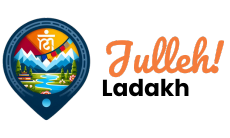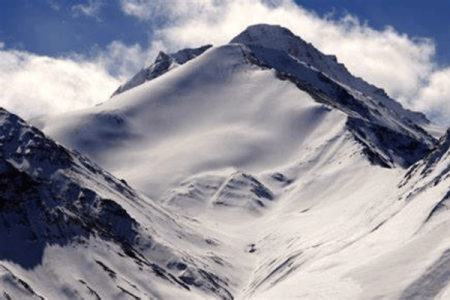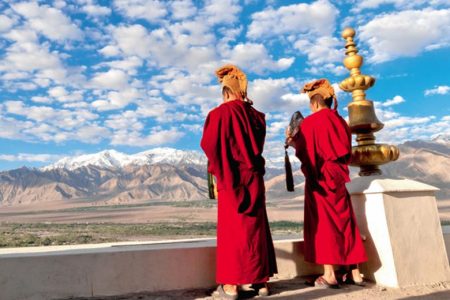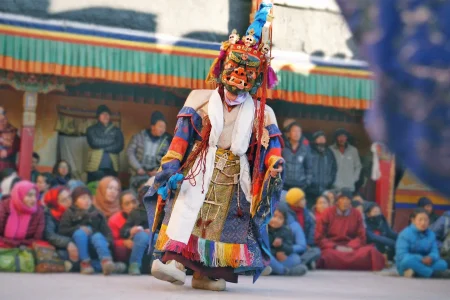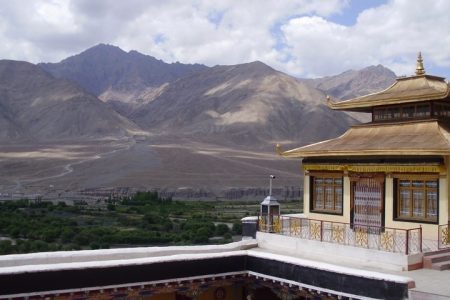Architectural Features and Layout
Fossil Rock in Gyameru, located in the Nubra Valley of Ladakh, is a remarkable natural feature rather than an architectural structure. The site consists of ancient rock formations that house fossilized remains of prehistoric life. The area is marked by rugged, weathered cliffs and rocky outcrops, where the fossils are embedded within the sedimentary layers. These formations are exposed due to erosion over thousands of years, revealing the prehistoric past of the region. The site’s layout is largely defined by its geological formations, with fossil beds scattered across the landscape, creating an unusual and intriguing natural monument.
Main Assembly Area (Natural Geological Features)
Fossilized Remains: The most significant feature of Fossil Rock is the fossils embedded in the rocks, which include marine creatures and other prehistoric species that lived in the region millions of years ago, when Ladakh was covered by the Tethys Sea.
Rock Layers and Erosion: The fossil beds are located along the rocky slopes, where the layers of sedimentary rock have been exposed due to erosion. These rock layers hold the secrets of the region’s ancient geological history, creating a stunning contrast between the fossils and the harsh, dry landscape of the Nubra Valley.
Viewing Points: The site offers visitors a chance to observe the fossil-rich rock faces up close, with scenic viewpoints that allow for photography and exploration of the ancient remains.
Cultural Significance
While Fossil Rock itself is not tied to religious or cultural landmarks, it holds significant scientific and historical value for both researchers and visitors. The fossils found here offer insights into the ancient environment of Ladakh, providing clues about the Tethys Sea and the region’s prehistoric ecosystem. For local communities, the site is an intriguing reminder of the natural history and the vast time scales over which the land has evolved.
Fort-like Structure
Fossil Rock is not an artificial fort but its rugged, inaccessible location gives it a natural sense of fortification. Surrounded by rocky terrain and often secluded from nearby settlements, the site feels protected by the surrounding barren hills and vast desert-like landscapes. The geological layers that hold the fossils are almost like natural fortifications, preserving these ancient remnants from the surrounding environment.
Roof and Viewpoints
The viewpoints around Fossil Rock in Gyameru offer panoramic views of the Nubra Valley and the surrounding mountains. From the elevated vantage points, visitors can admire the expansive desert landscape, where the fossil-rich rocks stand as silent witnesses to the region’s ancient past. The dramatic backdrop of snow-capped peaks and rocky outcrops enhances the awe-inspiring atmosphere, making it a popular spot for photography and geological exploration.
1. Fossil Exploration
Historical Significance: Fossil Rock is known for its ancient rock formations and fossilized remains of plants and animals from prehistoric times. Visitors can engage in the exploration of the fossils, learning about the geological history of Ladakh and the region’s ancient life forms.
Cultural Narratives: Local guides often share fascinating folk tales and cultural stories related to the rock formations, blending natural history with Ladakhi folklore.
2. Traditional Ladakhi Music and Dance
After visiting the Fossil Rock, travelers can attend local cultural performances. These include traditional Ladakhi songs and dances that reflect the connection between the people of the region and the land they inhabit.
Singing and Dancing Around the Campfire: In some guided tours, travelers can participate in a communal evening with traditional music, storytelling, and dance, often under the starry sky of Ladakh.
3. Interaction with Local Villages
Homestay Experience: Visitors can stay with local Ladakhi families near Gyameru, where they can experience the traditional lifestyle. This could involve activities such as farming, cooking, or learning traditional crafts like weaving or pottery.
Cultural Exchange: Travelers can learn about local customs, Buddhist traditions, and the spiritual importance of the natural environment in Ladakh. It’s an opportunity to understand how the local culture integrates with the land.
4. Buddhist Temples and Monasteries
Monastery Visits: Ladakh is known for its Buddhist monasteries, and visitors can experience the spiritual side of the region by visiting a nearby monastery after exploring the fossil site. These monasteries offer insight into the practices, art, and architecture of Ladakh’s Buddhist community.
Prayer and Meditation: Some monasteries may offer opportunities for meditation or even Buddhist rituals, allowing travelers to connect with the peaceful atmosphere of the region.
5. Traditional Ladakhi Cuisine
After exploring the fossils, travelers can enjoy traditional Ladakhi meals such as thukpa (noodle soup), momos (dumplings), and chang (local barley beer). The meal is often prepared using local ingredients and recipes passed down through generations.
Cooking Classes: Some tour operators offer cooking classes where visitors can learn how to prepare traditional Ladakhi dishes, providing a deeper cultural experience.
6. Local Handicrafts and Art
Crafts and Souvenirs: Visitors can explore local markets where artisans sell their handmade crafts, such as woolen shawls, carpets, and wooden carvings. These crafts are often inspired by the region’s landscapes and culture.
Pottery Workshops: Some villages near Gyameru offer pottery workshops where visitors can try their hand at creating traditional Ladakhi pottery.
7. Trekking and Cultural Sightseeing
Trekking to Nearby Villages: In addition to the Fossil Rock site, trekkers can visit nearby villages and monasteries. The trekking routes often offer stunning views of the landscape, and guides provide insight into the culture and history of Ladakh.
Cultural Sightseeing: The trek often leads travelers to ancient sites like Lamayuru Monastery, Alchi Monastery, and other significant landmarks of Ladakhi culture.

